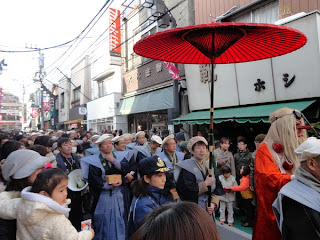Tengu - one of the most famous 'species' of Japanese supernatural beings - are everywhere in Japan. But, what they actually ARE is surprisingly unclear. How do you spot a Tengu?
Most of the Tengu statues I'd seen were in front of Buddhist shrines. So, to begin with, logically (to me at least) I assumed that a Tengu was some kind of benevolent guardian spirit, protecting a sacred place from harm. The one in the middle of this very useful-looking trio outside a shrine on Mt Takao, looks especially fierce...
...but the one on the left with the hawk's beak and wings looks the least human, which, I guessed, meant it was supposed to be the most powerful
But the one on the right was more difficult. It didn't look that impressive. In fact, the only difference between the Tengu and a regular old man with a big nose was its wings...which were almost completely hidden behind it
But, it was the old man Tengu on the right that really got me thinking. What protector-demon would choose to present itself as a fat retired warrior? What being has not one, not two, but
three different versions of itself standing outside a Buddhist temple?
A quick search later, I was more confused and none the wiser. Tengu can be almost anything. Sometimes they are scary goblins / ghosts...
...and sometimes, god-like swordfighting teachers
...but quite often they also appear as bird-featured Yokai shapeshifters
Animal shapes have nothing to do with a Tengu's power rating, either (if anything bird-Tengu are less powerful than the more human-looking ones) so my first assumption was resoundingly wrong. Classifying these beings was going to be more of a challenge than I'd signed up for. But, ever-curious, I forged ahead anyway.
So, Tengu appear in lots of different roles: fine. But, do the different Tengu have any common characteristics - anything that might help justify the fact that they are all called by the same name?
I needed help.
Luckily, I didn't have to look far: the first answer was in
Dai-e, the very next Noh play I read. The main character was a Tengu from Mt Hiei. All the other Tengu I'd come across also live on mountains, protecting a Buddhist shrine. So the first thing I learnt was
Tengu live in - perhaps are tied to - particular mountains
So far, so good. But the
Dai-e Tengu seems more mountain-dwelling dress-up artist than protector. First, it appears in disguise, as a wise priest, hiding its Tengu features behind a human 'mask' (unusually for a Noh main character, the actor appears unmasked). The Tengu meets a traveller who had once saved its life, and as a thank you gesture the Tengu promises to grant the traveller a wish. The traveller wants nothing more than to see and worship the great Buddhist sage Sakyamuni. Unsurprisingly, the Tengu doesn't know the great Sage well enough to ask him over, so it decides to fake it. The next time the Tengu appears, it is
as Sakyamuni, wearing a huge mask, with lots of small Tengu posing as 'disciples'.
At no point in the play does the Tengu appear in a recognisably Tengu-like representation - something like this
or, this
Lesson 2 was reasonably clear:
Tengu like dressing up as other people
Now I felt like I was at least getting
somewhere. So, Tengu seem to be good at changing shape. Unfortunately for them though, their acting skills are rather less impressive than their costume choices. At the end of
Dai-e, and in other plays, the Tengu's scheme is discovered by
an angry deity who chases the Tengu off into the mountains. Ooops!
Then, from the folk tale
Tengu no Hyotan (where a Tengu tries to play a nasty prank on a Gambler, but actually ends up making him a very rich and happy man) I also discovered that Tengu like to play jokes on people and try to outwit them. But it never quite works out that way: either the baddie gets his just desserts by accident, or the Tengu makes a fatal mistake, allowing the baddie to outwit
it. Oh dear.
So, I thought it would be safe to say that I had learnt my third lesson:
Tengu are not very good Tricksters
Armed with these three lessons, I thought I'd got a pretty good idea of what Tengu were: powerful, mountain-dwelling figures of fun. Mostly. But where does the 'wise teacher / expert swordfighter' role come in? In the famous Noh play
Kurama Tengu, the main character (dressed up as a priest
less noble than itself) trains a young boy who later becomes Japan's most famous General, in the arts of war...
Arrgh!
At this point, I decided to quit while I still could.
In the world of Japanese monsters, Tengu are clearly more of a
continent than a species. But at least I know enough about them now to recognise one. Possibly. Provided it hasn't made an extra special effort with that day's disguise...













































